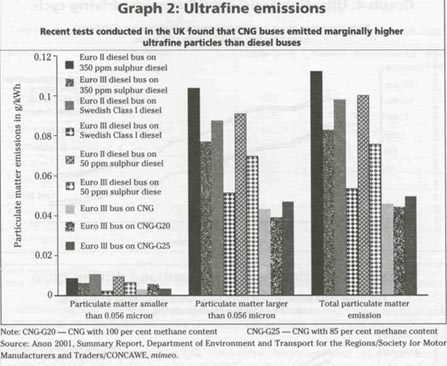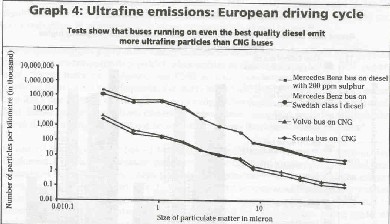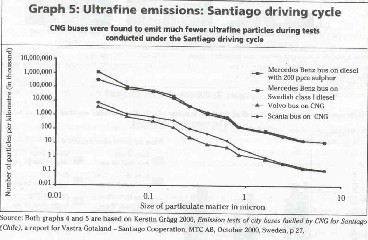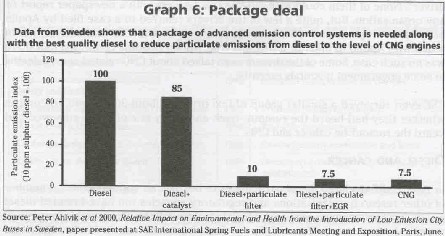Dinesh
Mohan of Delhi IIT cites a European study that has revealed that CNG emits
even finer particles than diesel which have greater propensity to enter
the lungs thereby making the CNG option that much more dangerous (Business
Standard, May 21,2001).
Fact
The detractors of CNG pull out extremely
limited and yet unproven data to claim that CNG vehicles emit more ultrafine
particles.
While particles come from all kinds of combustion sources it is the toxicity
of the particulate emissions that help to prioritise the control of emissions.
Particulate emissions from diesel vehicles are tiny and are coated with
extremely toxic chemicals called polycyclic aromatic hydrocarbon (PAH)
some of which are known to be the most potent carcinogens.
Numerous studies are now available that establish that CNG is a cleaner
fuel compared to diesel.
Issues
get murkier when the problems associated with diesel are hurled back at
CNG. So if diesel emits high amount of fine particles so does CNG —
is now a common refrain. The limited evidence the CNG detractors pull
out of their bag is a “study” done by the US-based Harvard Centre
for Risk Analysis, which contends that CNG vehicles emit more ultra fine
particles (also called nanoparticles) than diesel vehicles.20 In 2000
this “Harvard” study had mysteriously made its way to the tables
of all top decision-makers in the Delhi government. The Lieutenant Governor
of Delhi went on record to the media arguing that CNG was a problem because
of “nanoparticles”. TERI researchers use this study to support
their claim as well.
The “Harvard” study when examined was found to be a six-page
pamphlet, which was a literature survey with no references to the information
cited. Moreover, the study was funded by the world’s largest truck
manufacturer — Navistar International. Michael Walsh, a highly respected
air pollution expert and former official of the USEPA says of the study,
“Any undergraduate who turned such a report in to his professor would
surely get a very poor grade.”
The lobbies at work completely ignore the fact that while particles come
from all kind of combustion sources, it is the toxicity of the particulate
emissions that should guide prioritising the control of emissions. Across
the world, scientific studies have established that particulate matter
from diesel exhaust is extremely toxic. It comprises tiny particles coated
with extremely toxic chemicals called polycyclic aromatic hydrocarbons
(PAH), some of which are known to be the most potent carcinogens. Compared
with diesel vehicles, CNG vehicles emit negligible amount of particles.
Moreover, even the little particles that are emitted by CNG vehicles are
not as toxic as particles emitted by diesel vehicles as CNG is composed
of mainly methane gas.
While particles come from all kinds of combustion sources it is the toxicity of the particulate emissions that help to prioritise the strategies for control of emissions.
More studies are now available to confirm
that diesel vehicles emit more ultra-fine particles than CNG vehicles.
The Harvard study was first countered by the US Department of Energy (DOE),
when it came out with a paper called Separating Myth from Fact, in April
2000. The paper said CNG buses consistently emit dramatically less particulate
matter than diesel buses. Emissions testing of on-road buses in Boulder,Colorado,
on the central business district (CBD) driving cycle of the US demonstrated
a 97 per cent reduction in particulate matter emission and a 58 per cent
reduction in nitrogen oxide when compared to diesel buses.21
The trace amount of particulate matter associated with CNG is attributed
to crankcase lubricating oil consumption (which also occurs in diesel
engines). The DOE report said, “Some tests have shown that CNG actually
produces much fewer ultrafine particles than diesel fuel. However, the
study of particle size distribution measurement and ultra fine particle
counting are developing technologies, and initial data is mixed. New diesel
engines have been observed to emit more ultrafine particles while at the
same time emitting less total particulate matter mass than older diesel
engines.”
In one of his papers published in 2000, by the US-based Society of Automotive
Engineers, Christopher Weaver, president of the California-based Engine,
Fuel, and Emissions Engineering, Inc. says that even deterioration of
the natural gas engine does not have significant effect on particulate
emissions. “Particulate matter emissions from natural gas engines
are unlikely to increase substantially due to wear or inadequate maintenance
— at least until the piston rings, valve seals, or turbocharger oil
seals are so worn that oil control is lost,” says Weaver. According
to him, this is not surprising, since particulate matter emissions from
natural gas engines are derived from lubricating oil rather than fuel
combustion.22
When the Department of Environment and Transport for the Regions (DETR)
of the Government of UK tested emissions from buses run on CNG and diesel,
the results showed that the mass of ultrafine particles smaller than 0.056
micron (a micron is a millionth of a metre) emitted by CNG bus was just
marginally higher than a Euro III diesel bus run on Swedish Class 1 diesel
fuel (which has a sulphur content of 10 ppm). But diesel buses were found
to emit more particles, bigger than 0.056 micron, than the CNG buses23
(see graph 2: Ultrafine emissions).
But when the number of the ultrafine particles was considered, the Euro
III bus on the Swedish Class 1 diesel was found to emit many more particles
both smaller and larger than 0.05 micron compared to the CNG bus24 (see
graph 3: More from diesel). This clearly shows that ultrafine particle
emissions remain a problem even with advanced diesel engines.
Again, when the Sweden-based Motor Test Centre (MTC) tested emissions
from diesel and CNG buses, it observed similar results. The buses were
tested on two driving cycles — the European and Santiago driving
cycles. On both driving cycles the number of ultrafine particles (smaller
than 0.1 micron in this study) emitted by the diesel engine was much higher
than emissions from CNG buses25 (see graph 4: Ultrafine emissions: European
driving cycle, and graph 5: Ultrafine emissions: Santiago driving cycle).
More studies prove that CNG is a much cleaner option.
The
trace amount of particulate matter associated with CNG is attributed to
crankcase lubricating oil consumption which also occurs in diesel engines.
It is surprising how CNG detractors ignore a large number of studies that
show CNG is a much cleaner fuel. Even the basic science of clean fuels
eludes them. In its report on clean fuel, submitted to the Supreme Court,
EPCA clearly states that no hydrocarbon fuel can be treated as a clean
fuel. But based on the nature and structure of hydrocarbons it is possible
to classify some of them as environmentally acceptable fuels. So the report
states, “The pollution potential of the hydrocarbon fuels depends
on the ratio of carbon to hydrogen atoms. Petrol and diesel belong to
long-chain hydrocarbons with a larger number of carbon atoms forming the
chain with hydrogen atoms. On the other hand, fuels like CNG, LPG and
propane belong to the group of short-chain hydrocarbons having lesser
number of carbon atoms. Hence, the latter are
 |

|

|

|
less
polluting. This factor, together with the combined effect of fuel characteristics,
fuel additives and exhaust treatment systems in automobiles as well as
secondary pollutants generated through atmospheric reactions, is the reason
for air pollution and its health effect caused by automobile emissions.”26
Emissions results of CNG vehicles available from different countries confirm
that CNG vehicles are inherently cleaner than diesel vehicles. A report
from Canada, published in 2000, compiles emissions test results from across
the US and Canada which show that CNG buses emit up to 43 times less particles
than comparable diesel engines fitted with particulate traps27 (see table
6: Clean chit).
CNG also wins the race for cleaner fuels because of lower emissions of
other gaseous pollutants. Swedish test results show that a CNG bus emits
lower non-methane hydrocarbon and oxides of nitrogen compared to Euro
II diesel bus with particulate trap.28 For a Euro II diesel bus running
on diesel with 10 ppm sulphur (0.001 per cent) to achieve emission levels
comparable to that of a CNG bus, would need exhaust gas recirculation
system in addition to a particulate filter29 (see graph 6: Package deal).
When the DETR, government of UK, conducted emissions test on diesel buses
running on 0.005 per cent (50 ppm) and 0.001 per cent (10 ppm) sulphur
diesel fitted with particulate traps, and CNG buses, it found that particulate
emissions from Euro I bus fitted with CRT using 10 ppm sulphur diesel
was close to that from a CNG bus. But running the CRT-fitted Euro I diesel
bus on 50 ppm (0.005 per cent) sulphur produced greater particulate emissions
than the CNG bus.30
The CNG bus gave better results despite the fact that it was tested on
a transient cycle while the Euro I bus with CRT was tested on a steady
state cycle. A transient test cycle is more representative of real driving
conditions, emits more pollutants than a steady state cycle. Moreover,
the CNG bus tested had a stoichiometric engine and only an oxidation catalyst
which is not the state of the art technology. A three-way catalyst, would
have given even better results.31
A package of advanced emission control systems
is needed along with the best quality diesel to reduce particulate emissions
from diesel to the level of CNG engines.
